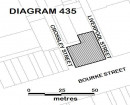CANTERBURY AMBULANCE STATION
61 Canterbury Road CANTERBURY, BOROONDARA CITY
-
Add to tour
You must log in to do that.
-
Share
-
Shortlist place
You must log in to do that.
- Download report


Statement of Significance
What is Significant?
The Canterbury Ambulance Station at 61 Canterbury Road, Canterbury, is significant. It was built for the Victorian Civil Ambulance Service (VCAS) in 1931 by builder S.L. Watsford.
It is a small, cubical clinker brick building with a tiled hipped roof set behind low front and side parapets. The centre bay is expressed as a shallow breakfront emphasised by a higher parapet. The facade is ornamented with red brick dressings to openings and bas-relief ornament over the vehicular entrance and windows. Roundels above the windows read 'Nulla Vestigia Retrorsum' (No going back), which was the motto of St John Ambulance and VCAS.
The rear extension is not significant.
How is it significant?
The Canterbury Ambulance Station is of local historical and representative significance and rarity value to the City of Boroondara.
Why is it significant?
The Canterbury Ambulance Station is of historical significance for demonstrating the early history of the Victorian Civil Ambulance Service (VCAS) and its interwar expansion plans. VCAS was created in 1914 as a continuation of the not-for-profit ambulance services provided by St John's Ambulance in Melbourne from 1893, and was intended to differentiate the ambulance service from St John's other services. In 1925, VCAS was finally making a small profit and decided to build eight new ambulance stations in the 'outer suburbs'. They did not raise the necessary funds until the 1930s, and the first station constructed was the Canterbury Ambulance Station in 1931. It served the cities of Camberwell, Hawthorn, Kew, Box Hill and Blackburn-Mitcham. VCAS only managed to build one more of the planned eight stations, for Footscray in 1933 (demolished). (Criterion A)
The Canterbury Ambulance station is rare as the only known interwar ambulance station in the Melbourne metropolitan area. (Criterion B)
The Canterbury Ambulance Station is of architectural significance as a representative interwar community building in the Stripped Classical style. (Criterion D)
-
-
CANTERBURY AMBULANCE STATION - Physical Description 1
The Canterbury Ambulance Station stands on the north side of Canterbury Road, just east of Gwenda Avenue. It is set back from the footpath behind a wide driveway to facilitate ambulance movement.
It is a small, cubical building with a tiled hipped roof set behind low front and side parapets. The front wall is faced with clinker brick while the side elevations are simple red brick. There is a stepped band of render along the top of the parapet, and cast-cement bas-relief ornament below.
The facade is very restrained Stripped Classical in style. It is articulated in three bays, with the wide central bay expressed as a breakfront with a higher parapet, though it only projects by a single brick depth. There is a large vehicular door (a modern, glazed replacement) at the centre. It has bullnose red brick dressings and a wide concrete lintel. The lintel is decorated with cast-concrete bas-relief patterns including a medallion in the middle of a rinceaux pattern, and fleur-de-lys in roundels on either side.
Each of the lower side bays has a single window, with a red brick flat-arch lintel and bullnose sill. The windows are steel-framed with textured glass; four large fixed panes above two hopper panes. Above each window is a large bas-relief medallion depicting a sundial and the Latin phrase 'Nulla Vestigia Retrorsum'. This is the motto of St John Ambulance and the VCAS and means 'No Going Back' (Table Talk 5 July 1923:32), which also adorned the facade of the VCAS headquarters at 64 Lonsdale Street, Melbourne (demolished).
There is an upper-storey extension which sits atop the rear quarter of the original extent of the building. It is a very austere grey metal-clad box with a flat roof. While it is not particularly sympathetic to the design of the ambulance station, it is set well back from the street.
Apart from the extension, and replacement of the vehicular door, the building is highly intact.
Heritage Study and Grading
Boroondara - Municipal-Wide Heritage Gap Study: Vol. 1 Canterbury
Author: Context
Year: 2018
Grading: Local
-
-
-
-
-
PARLINGTON
 Victorian Heritage Register H0731
Victorian Heritage Register H0731 -
FROGNALL
 Victorian Heritage Register H0707
Victorian Heritage Register H0707 -
SECOND CHURCH OF CHRIST SCIENTIST
 Victorian Heritage Register H1196
Victorian Heritage Register H1196
-
"1890"
 Yarra City
Yarra City -
"AMF Officers" Shed
 Moorabool Shire
Moorabool Shire -
"AQUA PROFONDA" SIGN, FITZROY POOL
 Victorian Heritage Register H1687
Victorian Heritage Register H1687
-
-












